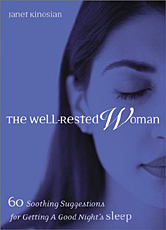More than half the women surveyed in a National Sleep Foundation Women and Sleep Poll reported insomnia symptoms sometime during every month. Other studies indicate that nearly 30 million American women long every day for a good night's sleep. Janet Kinosian, a journalist for the Los Angeles Times and other publications, was one of them. She spent 15 years learning "what to do and not to do to help get a better night's rest." Her sleep solutions are organized into chapters on creating the right environment, de-stressing the mind, fine-tuning the body, soothing the soul, and sleep hazards. Brief essays filled with personal stories and interesting research explain each strategy.
Kinosian outlines common sleep disorders and identifies medical problems that have poor sleep as a symptom, advising readers to see a doctor as the first line of action. She addresses how women's hormones affect sleep during menstruation, pregnancy, perimenopause, and menopause. Women suffering from depression and seasonal affective disorder also experience disturbed slumber.
To get a better night's sleep, women need to make both body and mind changes. For example, Kinosian recommends rearranging the bedroom so that the TV, clocks, and reading material don't distract you when you are trying to sleep. Use filters and plants to purify the air. Don't watch the news before going to bed. Instead, design a bedtime ritual, such as journaling, listening to lullabies, or taking a bath. Wind down by doing a slow dance in the same rhythm as a Gregorian chant. "Bend, reach, tremble, stir, vibrate; just move as if no one is watching, because no one is." Or try visualizations during that period when you are about to drop off to sleep. "One thing researchers claim: Things that fall downward seem to be more sleep inducing than things that move upward. So fill your night dreams with banana-yellow Cadillacs circling down mountains, pink hankies falling from the sky, red-painted moons swinging lower and lower to Earth."
